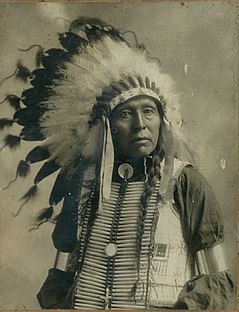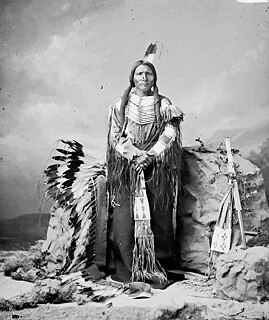 W
WRed Cloud's War was an armed conflict between an alliance of the Lakota, Northern Cheyenne, and Northern Arapaho peoples and the United States that took place in the Wyoming and Montana territories from 1866 to 1868. The war was fought over control of the western Powder River Country in present north-central Wyoming. This grassland, rich in buffalo, was traditionally Crow Indian land, but the Lakota had recently taken control. The Crow tribe held the treaty right to the disputed area, according to the major agreement reached at Fort Laramie in 1851. All involved in "Red Cloud's War" were parties in that treaty.
 W
WCrazy Horse ; was a Lakota war leader of the Oglala band in the 19th century. He took up arms against the United States federal government to fight against encroachment by white American settlers on Native American territory and to preserve the traditional way of life of the Lakota people. His participation in several famous battles of the Black Hills War on the northern Great Plains, among them the Fetterman Fight in 1866 in which he acted as a decoy and the Battle of the Little Bighorn in 1876 in which he led a war party to victory, earned him great respect from both his enemies and his own people.
 W
WThe Fetterman Fight, also known as the Fetterman Massacre or the Battle of the Hundred-in-the-Hands or the Battle of a Hundred Slain, was a battle during Red Cloud's War on December 21, 1866, between a confederation of the Lakota, Cheyenne, and Arapaho tribes and a detachment of the United States Army, based at Fort Phil Kearny, Wyoming. The U.S. military mission was intended to protect travelers on the Bozeman Trail.
 W
WWilliam Judd Fetterman was an officer in the United States Army during the American Civil War and the subsequent Red Cloud's War on the Great Plains. Fetterman and his command of 80 men were killed in the Fetterman Fight.
 W
WFlying Hawk was an Oglala Lakota warrior, historian, educator and philosopher. Flying Hawk's life chronicles the history of the Oglala Lakota people through the 19th and early 20th centuries, as he fought to deflect the worst effects of white rule; educate his people and preserve sacred Oglala Lakota land and heritage. Chief Flying Hawk was a combatant in Red Cloud's War and in nearly all of the fights with the U.S. Army during the Great Sioux War of 1876. He fought alongside his first cousin Crazy Horse and his brothers Kicking Bear and Black Fox II in the Battle of the Little Big Horn in 1876, and was present at the death of Crazy Horse in 1877 and the Wounded Knee Massacre of 1890. Chief Flying Hawk was one of the five warrior cousins who sacrificed blood and flesh for Crazy Horse at the Last Sun Dance of 1877. Chief Flying Hawk was the author of his commentaries and accounts of the Battle of the Little Big Horn, Crazy Horse and the Wounded Knee Massacre, and of Native American warriors and statesmen from who fought to protect their families, defend the invasion of their lands and preserve their culture. Chief Flying Hawk was probably the longest standing Wild Wester, traveling for over 30 years throughout the United States and Europe from about 1898 to about 1930. Chief Flying Hawk was an educator and believed public education was essential to preserve Lakota culture. He frequently visited public schools for presentations. Chief Flying Hawk leaves a legacy of Native American philosophy and his winter count covers nearly 150 years of Lakota history.
 W
WFort Phil Kearny was an outpost of the United States Army that existed in the late 1860s in present-day northeastern Wyoming along the Bozeman Trail. Construction began in 1866 on Friday, July 13, by Companies A, C, E, and H of the 2nd Battalion, 18th Infantry, under the direction of the regimental commander and Mountain District commander Colonel Henry B. Carrington.
 W
WFort Reno also known as Fort Connor or Old Fort Reno, was a wooden fort established on August 15, 1865 by the United States Army in Dakota Territory in present-day Johnson County, Wyoming. The fort was built to protect travelers on the Bozeman Trail from Native American tribes.
 W
WLittle Big Man, or Charging Bear, was an Oglala Lakota, or Oglala Sioux, who was a fearless and respected warrior who fought under, and was distant cousin to, Crazy Horse ("His-Horse-Is-Crazy"). He opposed the 1868 Treaty of Fort Laramie and fought against efforts by the United States to take control of the ancestral Sioux lands in the Black Hills area of the Dakota Territory. He also fought at the Battle of Little Big Horn in the Montana Territory in 1876. Late in life he decided to cooperate with the U.S. and may have been involved in the murder of his old ally and rival, Crazy Horse, at Fort Robinson in Nebraska in 1877.
 W
WThe Powder River Country is the Powder River Basin area of the Great Plains in northeastern Wyoming, United States. The area is loosely defined as that between the Bighorn Mountains and the Black Hills, in the upper drainage areas of the Powder, Tongue, and Little Bighorn rivers.
 W
WRed Cloud was one of the most important leaders of the Oglala Lakota from 1868 to 1909. He was one of the most capable Native American opponents whom the United States Army faced in its mission to occupy the western territories, defeating the United States during Red Cloud's War, which was a fight over control of the Powder River Country in northeastern Wyoming and southern Montana. The largest action of the war was the Fetterman Fight, with 81 U.S soldiers killed; it was the worst military defeat suffered by the Army on the Great Plains until the Battle of the Little Bighorn 10 years later.
 W
WThe Treaty of Fort Laramie is an agreement between the United States and the Oglala, Miniconjou, and Brulé bands of Lakota people, Yanktonai Dakota and Arapaho Nation, following the failure of the first Fort Laramie treaty, signed in 1851.
 W
WThe Wagon Box Fight was an engagement which occured on August 2, 1867, in the vicinity of Fort Phil Kearny during Red Cloud's War. A party of twenty-six U.S. Army soldiers and six civilians were attacked by several hundred Lakota Sioux warriors. Although outnumbered, the soldiers were armed with newly supplied breech-loading Springfield Model 1866 rifles and lever-action Henry rifles, and had a defensive wall of wagon boxes to protect them. They held off the attackers for hours with few casualties, although they lost a large number of horses and mules driven off by the raiders.